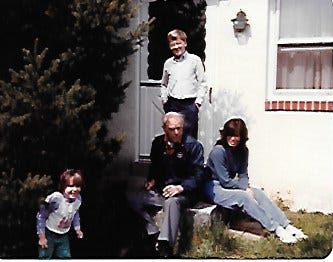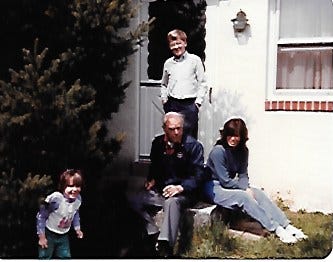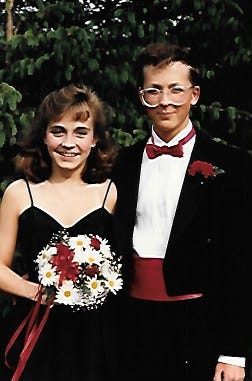[ad_1]
PAST
When I was 14 years old, I was still living with my mom, stepfather and sister in rural Connecticut. Our family dynamics were acrimonious. We tried to resolve matters with a family therapist who I had known since I was a “hyperactive” little boy placed on Ritalin. Ultimately, he fired us as his clients, because he thought he couldn’t do anything to help us. Not long after that, I ran away and landed at my dad and stepmother‘s for a brief spell. My stepmother was not interested in me joining their family unit and presented me with two options: go to boarding school or go live with your paternal grandparents. To their immense and eternal credit, my Nana and Pop pop had been tracking my misadventures as a young teenager and stepped into the gap to offer me a home. After settling the legal details, my father delivered me to Nana and Pop pop in March 1983.
The feeling I remember at that time was one of immense relief. Nana had cleared out the contents of a bureau in the bedroom; a bedroom which I had known from infancy, when we woud visit Nana and Pop pop for holidays. The room had bright yellow and orange flowered wallpaper and two creaky twin beds with feather pillows. There were the sounds of the tinkling radiators at night , the creaking springs of the bed as I turned on it, and the smells of old dog, cigar smoke and yummy cooking. I found these all immensely comforting.
There was of course a honeymoon stage. Pop pop and I had always played gin rummy when I would visit, so after I first arrived, we had a routine of playing several rounds of gin when I got home from school. I started to get better and better at cards, and then to beat him, which was incredibly frustrating for him. Within a relatively short period of time our games lost that spirit of playful competition because he would reliably get angry at losing, and so sadly, we stopped playing.
Pop pop’s uniform consisted of navy Dickies pants and shirt that he would wear when he was working on cars. This uniform was the same one he had worn for forty-five years when he ran his service station. He wore a working man’s Oxford shoe with slip resistant rubber soles. I needed some new clothes and so the first clothes I got were similar blue pants and the same kind of shoes from the local shoe store.
I was ahead of my peers in Spanish because of the excellent public school system I had attended in Connecticut. One of the classes I entered midstream was senior-level Spanish. I realize that the students were very gentle with me, considering what a big dork I was. I remember Susan, one of the pretty girls from the field hockey team, commenting without judgment “You look like a miniature version of your grandfather with your work shoes and Dickies.” At the time I was proud of that and didn’t realize it was a social liability. By the time I graduated, I had reinvented myself to such a degree that I was voted best dressed guy in my graduating class. This actually became one of many points of contention between my Pop-pop and me, as he would call me a fashion plate as I headed out for the bus in the morning.
Nana and Pop pop had not been engaged in parenting for 20 years and a lot had changed during that time. Despite the fact that I was a straight A student and graduated second in my class, my Nana remained convinced that I was a drug user, who would surreptitiously drink alcohol at late night parties. Nothing could’ve been farther from the truth, but I think she was watching too much TV. That’s what could happen if all you watch is soap operas and Donahue.
During this time we had to get to know each other as imperfect human beings on a daily basis rather than the grandson and grandparents we each knew from occasional and relatively short visits during holidays. One thing which shocked me was hearing my Nana swear. Keep in mind that she looked like a little old lady, who spent the better part of her day, sitting on the couch, knitting sweaters, and watching soap operas. I was also coming from a household ruled by a Navy Captain for whom uttering the word crap was a punishable offense. I nearly fell off my chair the day I heard my Nana in the kitchen say “Oh shit.”
I also came to feel the tension between my Nana and Pop pop and understood that it had very old roots. My Pop pop at the age of twenty seven, enlisted in the Marines to go fight in the Pacific during World War II. He didn’t have to, and left for uncertainty and danger, leaving my Nana and two young boys behind. During that time, my Nana had what would later be called a “nervous breakdown.” I don’t believe she ever forgave my Pop pop for that, and I don’t think there’s anything he ever could’ve done to make up for that lost time. They didn’t stop loving each other, but that bone of contention was right there between them every day since 1945.
Pop pop had lots of stories that he told over and over. They used to fascinate me as a boy but living with Nana and Pop Pop, and hearing the stories for the fifth, sixth or seventh time was a little bit wearisome. He had multiple phrases that he’d like to use. Some of the most memorable would be “More _____ than you can shake a stick at,” or “I wouldn’t give you a nickel for a box car full of them,” or “I told him to take a long walk off a short pier.” My all-time favorite had to do with gauging the trustworthiness of someone. He would say “If he goes to church check him twice. If he sings in the choir, check him three times.”
My Nana had her own phrases which tended to be darker. I had never heard these as a boy growing up, but they came out in day-to-day life and close proximity. For instance, “More people dead, more blood in the gutter, and no spoon to eat it with.” Or the alarming “Just take me out behind the barn and shoot me.” Or, most relevant to today’s discussion, “Growing old is for the birds. “
When I was a senior in high school, I had the lead in a play called You Can’t Take It With You. I played the grandfather. My Nana and Pop Pop came to see the performance, and afterwards my Pop-pop commented —more than asked. “So that’s what I’m like?” It hurt my heart. I actually hadn’t considered that he would see my portrayal as a representation of him but it makes sense. I played the character as a man who walked as if in pain. Unfortunately, that was actually the case for my Pop pop. If his arthritis hadn’t been so bad, our relationship would have benefited from many walks in which we would not necessarily have had to speak, but could’ve enjoyed each other’s company and God’s magnificent creation.
In the many years since I lived in Parkerford with Nana and Pop pop, my perspective on aging has evolved. I no longer assume that aging inherently involves increased daily pain, loss of mental clarity, and increasing infirmity. Sometimes I wish that I could go back in time and heal my grandparents with the knowledge I have acquired since then.
RECENT PAST
I’ve spent countless hours in counseling, trying to move past the traumas of my childhood. I can accept that at any given time, taking into account all circumstances, and what they experienced as children themselves, my mother and father and step- parents always did the very best that they could do in the moment. That doesn’t mean that they didn’t mess up and that I got hurt.
It was my tremendous good fortune to have known four sets of grandparents during my childhood and adolescence. All of them were exceptional people. Where my parents mistepped, my grandparents filled in to impart what values and wisdom they could to help me in my journey.
I never knew until the day arrived how long it would take me to forgive my mother for the hardest times of my boyhood. It turns out I needed to turn fifty four. She visited Ithaca this last summer. My wife traveled north to visit my stepmother and so my mom and I had the house and time to ourselves. It was probably the most meaningful and delightful time I’ve experienced with my mother in my entire life.
One of the reasons our visit went so well is that my mom was able to listen to me talk about long-haul COVID, vaccine injury, my own experience as a vaccine injured person, and my experience treating patients over the last two years. She has no idea how famous Pierre is and how extraordinary it is that he and I found each other and became partners. That’s fine. I think she has some sense of the exceptional knowledge I have accumulated and how few people on the planet know what I know and do what we do as a team.
As lovely as her visit was, I don’t think I was able to effectively communicate how profoundly her decision to get boosters has affected her health and the pain which she experiences daily. At the end of the day, I’m still her son, not her treating physician. It may be hard to take too seriously the person whose dirty diapers you changed, who sass talked you when he was a teenager, or who has been hot and cold for decades of your relationship. My story is not that different than those of hundreds of other readers, who have felt disconnected and isolated from their families, friends, and neighbors as they become aware of the real dynamics behind this pandemic. I had to leave my home as a teenager to find another home. I’ve had to leave the healthcare system as I knew it, to help create a new healthcare system which prioritizes people and wellness above sickness and profit. I’ve chosen to care for the people in front of me who want my help, when I haven’t been able to protect the people I love.
PRESENT
To use another quote from my Pop-pop, “If I had a nickel for every time a patient told me that they thought their symptoms were simply a sign that they were getting older or out of shape, I would be a rich man.” In a vaccinated or boosted patient, with new symptoms of cognitive impairment, fatigue, muscle or joint pain, I think that we should assume it is spike-related until proven otherwise. It isn’t just because you haven’t been going on as many walks or eating too many Doritos.
In the last week, two different patients wanted to talk to me about a recent video which has Dr. Robin Rose of Terrain Health in Connecticut, and three other colleagues discussing a detox protocol. Robin was an early advisor of the FLCCC. There were many things in the video which I agreed with and which parallel my clinical experience. For example, Robin said that in microclot testing we have lost the controls and the best that you’ll find is a one out of four. In most long-haul and vaccine injured patients you’ll see a three, three and a half, or four out of four. Robin and her colleagues discussed a German study from 2023, which looked at the migration of spike in mice receiving IV injections of spike, and also cellular stains of brain tissue from human autopsies. Both Dr. Suzanne Gazda and I presented in reference to this study way back in May 2023 at the FLCCC conference on spikopathy.
The thing which Dr. Rose said which deserves focused attention is her statement re: triple anticoagulation. She said that triple herapy is very dangerous for many people. In our practice we have treated hundreds of patients with triple anticoagulation therapy. No one has required a transfusion, no one has died from this therapy. There have been a few nosebleeds, requiring an emergency department visit, and several menstruating women whose menses was so severe that we had to double check their CBC, and modify their treatment plan. On the other hand, there have been a long list of extraordinary improvements, and patients’ clinical symptom burden because of the effectiveness at treating microclotting. 99.9% of patients have seen a decline in their score over time. Two patient who haven’t seen this were surreptitiously using collagen which inhibits platelet activation and aggregation, and which I discussed in a previous Substack as a problem.
It is true that there are an increasing range of options for people to address microclotting. Dr. Rose puts forward a protocol which costs about $670 for six weeks of therapy and reports that it is very effective at safely decreasing spike and effectively decreasing micro clotting. In our practice, we have a robust discussion with patients regarding their clinical options. Triple anticoagulation therapy is one option. The range of other options includes enzymes, such as nattokinase, lumbrokinase, serrapetase, Flavay, and Baobab sipping. We have found that ivermectin is an extremely useful component of treating anticoagulation, because of how it inhibits spike activation of receptors on platelets, red blood cells and endothelial cells. The bottom line is that there is no single treatment which is going to work for every patient and these treatments are best delivered under the guidance of a knowledgeable practitioner.
It is equally important that among the still small cohort of practitioners who are treating patients with long Covid and vaccine injury that there is fastidious attention paid to the accuracy of statements which we make which could lead to depriving some patients of life-changing therapeutic interventions. It is always worth raising the question of what the financial interest is of the practitioner who is making such pronouncements. Do they stand to benfit financially from the therapeutics they are recommending? E.g. Dr Bruce Patterson owns the patent on Maraviroc. That doesn’t inherently mean that Maraviroc can’t be useful to some patients, but it’s a very expensive drug and an individual needs to keep this in mind when deciding whether or not to follow his protocol.
I’d also like to point out the risk of receiving care from a provider who is not up-to-speed with the clinical advances in understanding about micro clotting and spikopathy. This week our practice received multiple threatening and bullying calls from an orthopedic surgeon who was upset that his patient had developed a hematoma after major joint repair surgery. He displayed no understanding of microclotting or spikopathy and accused us of quackery. He blamed us for prescribing triple anticoagulation therapy when in fact, it had been ordered by a vascular surgeon participating in the patient’s case.
There are several important points here. The first is that the patient has a very high spike antibody level and elevated micro clotting, and so is much more likely to have a failed surgical procedure because of the inflammation and localized ischemia. The second point is that practitioners across the United States are slowly getting a clue (way ahead of the regulating and recommending bodies) that microclotting is a very powerful dynamic in the clinical setting. The third point is that knowledge about this is readily available for free to any practitioner who cares to stay abreast of the current reality and science based treatments for spikopathy and microclotting. Becoming a leading and trusted source of this knowledge has been a prime directive of the FLCCC Alliance.
Dr Jordan Vaughn has now given three separate presentations at three different FLCCC conferences regarding micro clotting and its treatment. He has safely delivered care, including the use of triple anticoagulation to more than 1600 patients and our practice has done the same with more than 200 patients. A pre-2019 understanding of coagulation is not only insufficient, but even harmful, and possibly dangerous in a physician’s treatment of a patient, especially in the context of surgery. The fact that a vascular surgeon from a conventional practitioner was willing and able to prescribe triple anticoagulation for our patient is a hopeful sign. Nevertheless, buyer beware. It makes sense to screen your providers with basic questions about what they understand about spikopathy, the pathologies that ensue and how to effectively treat them.
As an FLCCC Alliance-affiliated practitioner, I don’t think that we have all the answers. The protocols haven’t worked for every patient. I do think that under the scientific and medical leadership of Dr Paul Marik, there has been a rigorous standard of evidence applied to FLCCC Alliance recommendations and what makes it into first, second and third tiers. In a bewildering sea of sometimes conflicting medical advice, this foundation is invaluable as a North Star for patients and providers alike. Inevitably there will be honorable disagreements among providers re: the best path forward. Spirited discussion of emerging evidence and clinical responses will help lead to the best outcomes. This is the eternal flame, not yet extinguished, of scientific inquiry.
[ad_2]
Source link



